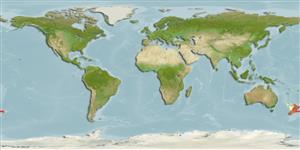Holocéphales (chimères) (chimaeras) >
Chimaeriformes (Chimaeras) >
Chimaeridae (Shortnose chimaeras or ratfishes)
Etymology: Hydrolagus: hydro-, combining form of hydor (Gr.), water; lagos (Gr.), hare, i.e., “water rabbit,” probably referring to three pairs of tooth plates, which tend to protrude from the mouth like a rabbit’s incisors. (See ETYFish); novaezealandiae: novus (L.), new, i.e., of New Zealand, in whose waters it occurs. (See ETYFish).
More on author: Fowler.
Environment: milieu / climate zone / depth range / distribution range
Écologie
marin bathydémersal; profondeur 25 - 950 m (Ref. 26346), usually 100 - 600 m (Ref. 89422). Deep-water; 34°S - 47°S
Southwest Pacific: endemic to New Zealand.
Taille / Poids / Âge
Maturity: Lm ? range ? - ? cm
Max length : 96.0 cm TL mâle / non sexé; (Ref. 26346); common length : 55.0 cm TL mâle / non sexé; (Ref. 9258)
Description synthétique
Morphologie | Morphométrie
Épines anales 0; Rayons mous anaux: 0. Dark grey dorsally, with silver-white markings, pale silver-grey ventrally (Ref. 26346).
Inhabits the outer continental shelf and upper slope (Ref. 26346). Feeds on crustaceans, shellfish, worms and small fish (Ref. 26346). Maximum length 87 cm without tail filament (Ref. 26346), assumed to have 96 cm TL. Marketed as fillets (Ref. 26346).
Life cycle and mating behavior
Maturité | Reproduction | Frai | Œufs | Fécondité | Larves
Oviparous, young hatch from egg case at about 9-12 cm (Ref. 26346).
Cox, G. and M. Francis, 1997. Sharks and rays of New Zealand. Canterbury Univ. Press, Univ. of Canterbury. 68 p. (Ref. 26346)
Statut dans la liste rouge de l'IUCN (Ref. 130435)
Menace pour l'homme
Harmless
Utilisations par l'homme
Pêcheries: intérêt commercial mineur
Plus d'informations
RéférencesAquacultureProfil d'aquacultureSouchesGénétiqueElectrophoresesHéritabilitéPathologiesTraitementNutrientsMass conversion
Outils
Articles particuliers
Télécharger en XML
Sources Internet
Estimates based on models
Preferred temperature (Ref.
123201): 8 - 13.7, mean 10.8 °C (based on 62 cells).
Phylogenetic diversity index (Ref.
82804): PD
50 = 0.5000 [Uniqueness, from 0.5 = low to 2.0 = high].
Bayesian length-weight: a=0.00240 (0.00122 - 0.00472), b=3.14 (2.96 - 3.32), in cm total length, based on LWR estimates for this species & (Sub)family-body (Ref.
93245).
Niveau trophique (Ref.
69278): 3.5 ±0.46 se; based on food items.
Résilience (Ref.
120179): Faible, temps minimum de doublement de population : 4,5 à 14 années (Assuming Fec <100).
Prior r = 0.28, 95% CL = 0.16 - 0.49, Based on 1 stock assessment.
Fishing Vulnerability (Ref.
59153): High vulnerability (58 of 100).
Climate Vulnerability (Ref.
125649): Very high vulnerability (76 of 100).
Nutrients (Ref.
124155): Calcium = 11.4 [3.1, 38.0] mg/100g; Iron = 0.389 [0.134, 0.967] mg/100g; Protein = 15.9 [10.4, 19.0] %; Omega3 = 0.266 [0.100, 0.709] g/100g; Selenium = 18 [5, 59] μg/100g; VitaminA = 6.22 [1.30, 27.04] μg/100g; Zinc = 0.326 [0.172, 0.627] mg/100g (wet weight);
